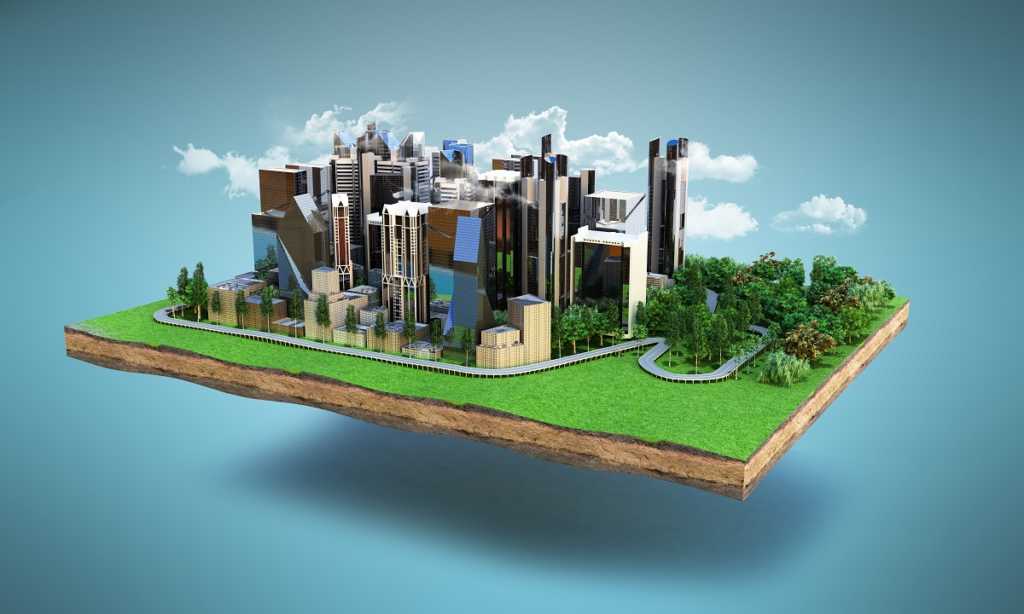Real estate is real property that consists of land and improvements, which include buildings, fixtures, roads, structures, and utility systems. Property rights give a title of ownership to the land, improvements, and natural resources such as minerals, plants, animals, water, etc.
Types of Real Estate
There are several types of real estate, each with a unique purpose and utility. The main categories are:
Land
Residential
Commercial
Industrial
For anyone looking to understand how the industry works and what each of the major categories represents, the explanations below will be a helpful guide.
#1 Land
Land is the baseline for all types of real property. Land typically refers to undeveloped property and vacant land. Developers acquire land and combine it with other properties (called assembly) and rezone it so they can increase the density and increase the value of the property.
#2 Residential
Residential real estate consists of housing for individuals, families, or groups of people. This is the most common type of estate and is the asset class that most people are familiar with. Within residential, there are single-family homes, apartments, condominiums, townhouses, and other types of living arrangements.
#3 Commercial
Commercial property refers to land and buildings that are used by businesses to carry out their operations. Examples include shopping malls, individual stores, office buildings, parking lots, medical centers, and hotels.
#4 Industrial
Industrial real estate refers to land and buildings that are used by industrial businesses for activities such as factories, mechanical productions, research and development, construction, transportation, logistics, and warehousing.
Examples of Real Estate
Now that we’ve outlined the four main categories, let’s explore some specific examples of different types of real property.
Single-family dwelling – Any home designed for only one family
Multi-family dwelling – Any group of homes designed for more than one family
Attached – Any unit that’s connected to another (not freestanding)
Apartment – An individual unit in a multi-unit building. The boundaries of the apartment are generally defined by a perimeter of locked or lockable doors. Often seen in multi-story apartment buildings.
Multi-family house – Often seen in multi-story detached buildings, where each floor is a separate apartment or unit.
Condominium (Condo) – A building with individual units owned by individual people.
Detached house – A free-standing building not connecting to anything else (a stereotypical “home”)
Portable house – Houses that can be moved on a flatbed truck
Mobile home – A vehicle on wheels that has a permanent residence attached to it
Villa – A building with only one room and typically a steep pointy roof
Hut – A dwelling typically made of raw materials such as bamboo, mud, and clay
Overview of Real Estate Industry
Let’s explore how the industry works and what the major jobs and careers are. The real estate industry can be divided into several different areas:
Development
Sales and marketing
Brokerage
Property management
Lending
Professional services (law, accounting, etc.)
Let’s look at each of these six areas of the industry in more detail.
#1 Development
Real estate development is a process that involves the purchase of raw land, rezoning, construction and renovation of buildings, and sale or lease of the finished product to end users. Developers earn a profit by adding value to the land (creating buildings or improvements, rezoning, etc.) and taking the risk of financing a project. Development firms create a new product, which can be thought of as the “primary market” or generation of new inventory.
#2 Sales and marketing
Sales and marketing firms work with developers to sell the buildings and units they create. These firms earn a commission for creating all marketing material and using their sales agents to sell the inventory of completed units. These firms typically focus on new units.
#3 Brokerage
A real estate brokerage is a firm that employs a team of real state agents (realtors) who help facilitate a transaction between the buyers and sellers of property. Their job is to represent either party and help them achieve a purchase or sale with the best possible terms.
#4 Property management
Property management firms help real estate owners rent out the units in their buildings. Their jobs include collecting rent, showing units, fixing deficiencies, performing repairs, and managing tenants. They charge a fee, typically a percentage of the rent, to property owners.
#5 Real estate lending
Lenders play a major role in the industry as virtually all properties and developments use leverage (debt) to finance their business. Lenders can include banks, credit unions, private lenders, and government institutions.
#6 Professional services
There are a variety of real estate professionals who work in the industry and help make it function. The most common examples (other than the ones listed above) are accountants, lawyers, interior designers, stagers, general contractors, construction workers, and tradespeople.
Careers in Real Estate
If you’re looking for a career in real estate, you may want to consider any of the above six areas of the industry.
Here are the most common jobs (titles) in the industry:
Analyst – Performing financial analysis and valuation of properties
Appraiser – Valuing properties
Agent – a sales agent or “realtor”
Building Inspector – Someone who examines buildings and works with appraisers
Commercial Broker – An agent who sells commercial properties
Director of Real Estate – A corporate job
Home Inspector – Someone hired to assess the quality of a home for a seller or purchaser
Loan Underwriter – A person who analyzes the creditworthiness of a borrower
Mortgage Specialist / Underwriter – A person who approves mortgage applications
Real Estate Attorney – A lawyer who specializes in real estate transactions
Source: Corporate finance institute





